|
Wooden Boats, Motorcycles, Noodles and Rice... |
| By Ken Preston
- Seattle, Washington - USA |
| Ken Preston wrote
to tell me that he had written and self-published
a book titled "The
Wooden Workboats of Viet Nam - A Photographic
Tour at the Turn of the 21st Century".
Sensing there might be a story there I asked him
to write about researching the book. The following
article is the result. Unfortunately we can not
reproduce Ken's beautiful images in their full
glory due to limited space, but you can download
the book at lulu.com
or buy a printed version - Chuck |

|
Two journeys, three motorbikes, 8000
miles of Vietnamese roads, two motorbike wrecks and
a dozen near misses, one case of dysentery, incredible
jungle mountains, logged over hillsides all planted
to tea and coffee or corn, magnificent white sand
beaches, whitewater rivers, cliffs falling straight
into the sea, waterfalls, landslides, thousands of
islands floating high above a misty sea, rivers spreading
through unbelievable expanses of rich farmland, cold
miserable drizzly rain blown on a steady North wind,
blistering sun in perfect blue skies, mud, dust. .
.and noodles and rice.
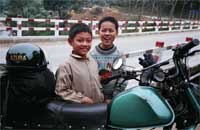 That’s the bike I rode the first trip, a
Minsk (made in Minsk, Belorussia) two stroke 120
cc dirt bike. It is heavier, dirtier, smokier
and stronger than the modern Honda style bikes
that are the norm in the country these days, but
it carries a bigger load and so is used in the
countryside rather like a pickup truck. Also by
expats living in Viet Nam who need a heavier machine.
The photo was taken about 30 miles South of the
Chinese border at a tiny open air café
next to a bridge over a little white water river.
There is no square foot of Viet Nam that is not
the responsibility of a Children’s Foreigner
Greeting Committee. Just stop and they’ll
introduce themselves
That’s the bike I rode the first trip, a
Minsk (made in Minsk, Belorussia) two stroke 120
cc dirt bike. It is heavier, dirtier, smokier
and stronger than the modern Honda style bikes
that are the norm in the country these days, but
it carries a bigger load and so is used in the
countryside rather like a pickup truck. Also by
expats living in Viet Nam who need a heavier machine.
The photo was taken about 30 miles South of the
Chinese border at a tiny open air café
next to a bridge over a little white water river.
There is no square foot of Viet Nam that is not
the responsibility of a Children’s Foreigner
Greeting Committee. Just stop and they’ll
introduce themselves |
Actually, that is just the start of
it. There were the 82 million Vietnamese, of whom
I personally met (rough numbers here, I didn’t
log them all) one half drunk fellow who wasn’t
really a highway robber and one very pretty pickpocket,
three people who were rude or unhelpful, ten thousand
cute kids who wanted their pictures taken (that might
be a bad under-estimate), two hundred people (more
or less) who insisted on taking me home for tea and
cookies, several hundred who finally figured out what
I was trying to ask and managed to show me the way
(or lead me on their own motorbikes) and put me back
on the road I needed, another hundred or so who stopped
me on the street to practice their English, forty
two or forty three talented motorbike mechanics, several
hundred really good cooks and one who was selling
hot salty water with a few noodles, some swamp weeds
and a very little gristle from a stand alongside the
road. I could go on and on. . .weddings and funerals
(all with fabulous banquets), delicious dinners with
absolute strangers in open air restaurants, mad dashes
on motorbike taxis all over strange towns looking
for motorbike parts.
 Just completed 22’ double ended utility
motor work boat under thatch building shade alongside
the road South of Quy Nhon (in the South Central
part of the country).
Just completed 22’ double ended utility
motor work boat under thatch building shade alongside
the road South of Quy Nhon (in the South Central
part of the country). |
All of that was just to find the boats,
rowing boats, motor boats, river boats, inshore boats
and distant water fishing boats, dredgers and freighters
and boats so small they get to their work on a bicycle.
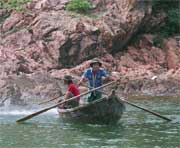 Two youngsters fishing in Quy Nhon Bay. They’ve
set several hundred feet of monofilament gill
net just offshore of the rocks, are now rowing
along and whipping the water with a bamboo switch
to scare fish out into the net. Note that the
boat is rowed standing facing forward and the
rowing position is in the forward 3rd of the boat,
a unique arrangement to my knowledge, but very
common in Quy Nhon.
Two youngsters fishing in Quy Nhon Bay. They’ve
set several hundred feet of monofilament gill
net just offshore of the rocks, are now rowing
along and whipping the water with a bamboo switch
to scare fish out into the net. Note that the
boat is rowed standing facing forward and the
rowing position is in the forward 3rd of the boat,
a unique arrangement to my knowledge, but very
common in Quy Nhon. |
Viet Nam is basically a very long coastline
with two river deltas, the Red River in the North
and the Mekong in the South. The country pushes up
into the mountains in the West and North just a little
ways, but then becomes Cambodia or Laos or China.
Thus the Vietnamese have been boat builders, fishermen
and sailors since time out of mind. More, their coast
with a number of fine harbors has long been a stopping
place for voyagers from far away, bringing boat designs
and building techniques from China, Japan, the Indian
Subcontinent and of course Europe and America in recent
centuries. The wooden boat culture, building and sailing
runs very deep in the country.
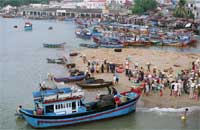 The
informal early morning fish market on a sandbar
just inside Nha Trang fishboat harbor. The formal
fish market is the long low building on the quay
in the back ground, but there’s very little
going on there. The fleet comes in just after
daylight and is met by dozens of shore boats that
take the catch ashore, where it’s washed,
sorted and quickly moved off to retail market.
Day-old fish is worthless here. Everyone wants
it fresh. Now and then a skipper just noses up
on to the sand to offload, though it’s still
usually into a shore boat. Nha Trang was a major
US base in the war, two good harbors and a magnificent
beach front, it’s one of Viet Nam’s
premier resort cities these days, with a wide
range of hotels and innumerable wonderful restaurants. The
informal early morning fish market on a sandbar
just inside Nha Trang fishboat harbor. The formal
fish market is the long low building on the quay
in the back ground, but there’s very little
going on there. The fleet comes in just after
daylight and is met by dozens of shore boats that
take the catch ashore, where it’s washed,
sorted and quickly moved off to retail market.
Day-old fish is worthless here. Everyone wants
it fresh. Now and then a skipper just noses up
on to the sand to offload, though it’s still
usually into a shore boat. Nha Trang was a major
US base in the war, two good harbors and a magnificent
beach front, it’s one of Viet Nam’s
premier resort cities these days, with a wide
range of hotels and innumerable wonderful restaurants.
|
I first saw Viet Nam as a soldier in
the American war. It was a better trip than many.
Nobody killed me. Perhaps more important, I didn’t
kill anybody either. Somehow I was just never in the
wrong place at the right time. I didn’t have
much chance for sight seeing though and my duties
were mostly in the highlands, away from the beaches
and harbors and even the Mekong, which was very close,
but beyond my normal boundaries. Still, now and then
I managed a trip to the coast for a day or two and
once with a Vietnamese friend for a weekend to visit
relatives in the Mekong Delta country, so I saw some
boats and took a few pictures.
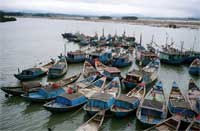 “Almost-double-enders”
rafted up above the highway bridge at Ron, a small
city on the North Central coast. This was a grey
drizzly miserable day in mid-January with a strong
North breeze harrying me along. I was wet and
cold and almost rode on by headed south looking
for warmth. I couldn’t pass up this moorage
though and stopped to spend an hour or so poking
around. The boats are not true double enders,
they have just a little bit of a transom. They’re
very close relatives to the biggest St. Pierre
dories. The largest of these boats at Ron are
over 60’ long. “Almost-double-enders”
rafted up above the highway bridge at Ron, a small
city on the North Central coast. This was a grey
drizzly miserable day in mid-January with a strong
North breeze harrying me along. I was wet and
cold and almost rode on by headed south looking
for warmth. I couldn’t pass up this moorage
though and stopped to spend an hour or so poking
around. The boats are not true double enders,
they have just a little bit of a transom. They’re
very close relatives to the biggest St. Pierre
dories. The largest of these boats at Ron are
over 60’ long. |
Fast forward 35 years. The world has
changed, Americans are welcomed in Viet Nam as tourists
and businessmen, magazines publish travel articles
and travel agencies have posters of Viet Nam on their
walls. In the posters, here and there are the boats,
colorful bits of background beyond the shining beaches.
So curiosity brought me back, to see how the country
had changed since those bitter years and whether or
not the boats were still being built and sailed along
that beautiful coast. I had no idea what it meant
when I announced to friends that I was going to take
a picture of “every boat in Viet Nam”,
not even if the boats and the boat yards were still
there. In the last hours of 2004 I got on a plane
to Hanoi with a backpack, two cameras, a box of film
and nowhere near enough warm clothes. It took me a
week in country, including a bus tour out to the coast
at Halong Bay to figure out that the best way to hunt
down all the little harbors and boat yards would be
to travel by motorbike, alone. Travel by bus, train
or plane is easy and inexpensive, but the busses,
trains and planes don’t go where I needed to
be. A car would be out of the question. I had two
months to do the job, so found a bike, bought some
warm clothes and rain gear and. . .headed up into
the Northwest Mountains, away from the coast.
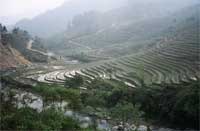 A
very ordinary terraced hillside on the road up
to Sapa, high in the Vietnamese Northwest, a few
miles from the Chinese border at Lao Cai. As the
mountains get steeper and drier the fields are
still terraced but planted to corn and vegetable
crops or sometimes cherry orchards. It’s
a very beautiful bit of the world, but there’s
not much level land to be had. A
very ordinary terraced hillside on the road up
to Sapa, high in the Vietnamese Northwest, a few
miles from the Chinese border at Lao Cai. As the
mountains get steeper and drier the fields are
still terraced but planted to corn and vegetable
crops or sometimes cherry orchards. It’s
a very beautiful bit of the world, but there’s
not much level land to be had. |
Uh, yes, well, the Northwest Mountains
are magical and pull a bike rider like a magnet, just
a day and a half out of Hanoi. The country is steep
and beautiful, pine and bamboo forests, terraced fields,
fascinating mountain people. The roads are narrow
and winding, often little more than paved trails in
the higher country. At the end of a week though, I
fled South, out of the rain and cold. All winter long,
the high pressure over central China pushes a bitter
cold 20 mile an hour wind down the Red River valley,
straight through the Himalayas and down to the South
China Sea at Haiphong, where it picks up the warm
moist sea air and holds it a thousand feet up and
leaves it to drizzle for weeks on end. Leaving Hanoi
I hurried South through the rain and cold, past who
knows what marvels. Finally at Hai Van Pass near Da
Nang I rode out of the cold and into the wonderful
winter weather of Southern Viet Nam and began carefully
poking along the coast.
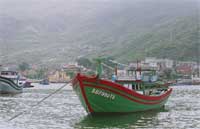 A
night-seiner, the little green boat uses the banks
of fluorescent lights to attract fish at night.
The net is a great heap of monofilament mesh.
I never got to sea to watch the work done, so
can’t tell you exactly how they fish. At
night though looking out to sea you can see 70
or 80 spots of light and hints of more over the
horizon, each one a fish boat working. In the
morning the fish market on the quay in the lagoon
side harbor is pandemonium, with hundreds of people
buying, sorting, washing and icing down fish and
moving them out to market in shoulder baskets,
bikes, cars and trucks. A
night-seiner, the little green boat uses the banks
of fluorescent lights to attract fish at night.
The net is a great heap of monofilament mesh.
I never got to sea to watch the work done, so
can’t tell you exactly how they fish. At
night though looking out to sea you can see 70
or 80 spots of light and hints of more over the
horizon, each one a fish boat working. In the
morning the fish market on the quay in the lagoon
side harbor is pandemonium, with hundreds of people
buying, sorting, washing and icing down fish and
moving them out to market in shoulder baskets,
bikes, cars and trucks. |
Thus that first trip focused more on
the South of the country and left a large gap in the
North. Home again, I struggled with the thousand odd
photos, hoping to make something out of them, but
they weren’t enough. I returned to the North
in September of 2006 for another try. This time the
weather was marvelous, though often hazy. On the second
trip I pushed North along the coast almost to the
Chinese border, then turned South and followed every
hint of a harbor or river mouth or beach along the
road. It was good hunting. The boats are there in
variety I’d never imagined. The fisheries are
still viable and boat yards all along the way are
building and repairing large boats and small. Another
thousand odd photos have almost finished the job.
I know there are a few boats I don’t have on
film. There’s an ugly cargo scow for moving
tractors and livestock around the delta that I never
got, and, just glimpsed through driving rain on my
last day homeward bound, another species of surf boat
on a narrow northern beach. Worse, I never saw Vung
Tau and only passed through Da Nang and Phan Thiet
en route and no doubt another month afloat on the
Mekong would turn up river boats I haven’t seen
yet. But for now, it will have to do. The photos are
sorted, the book is laid out and the captions all
written. There are maps to show the way if you want
to go see for yourself. I hope you do
 Sunrise
in the open roadstead in front of Quy Nhon. The
bulk of the city lies back along the highway and
the lagoon side, but the ocean beach front is
a very pleasant edge of town, several hotels and
restaurants along with many more utilitarian shops.
A large fleet of fishing boats lies anchored off
the beach and many are hauled out above high tide
line to be painted and repaired. Quy Nhon is not
a major resort city but ought to be. With the
beautiful bay, scenic mountains north and south
and the new road out of town to the South along
the cliffs above the ocean, it’s a delightful
place. The local moonshine can be used for cooking
fuel or paint thinner if you’re not thirsty. Sunrise
in the open roadstead in front of Quy Nhon. The
bulk of the city lies back along the highway and
the lagoon side, but the ocean beach front is
a very pleasant edge of town, several hotels and
restaurants along with many more utilitarian shops.
A large fleet of fishing boats lies anchored off
the beach and many are hauled out above high tide
line to be painted and repaired. Quy Nhon is not
a major resort city but ought to be. With the
beautiful bay, scenic mountains north and south
and the new road out of town to the South along
the cliffs above the ocean, it’s a delightful
place. The local moonshine can be used for cooking
fuel or paint thinner if you’re not thirsty. |
Ken Preston


Ken's book is available
from lulu.com
either as a download for $5 or as a printed version
- 223 pages, 8.5" x 11", perfect binding,
full-color interior ink - for $44.96

|